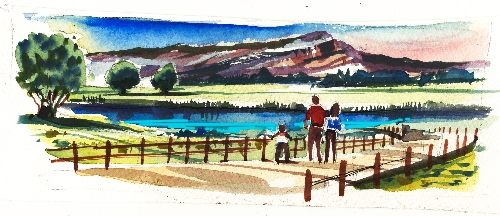Ash Meadows refuge to feature new boardwalks

New attractions await visitors to Ash Meadows National Wildlife Refuge this spring. Two new boardwalks through sensitive habitat around two major springs open to public use following official ceremonies on March 27. The half-mile boardwalks provide easy access to King’s Pool at Point of Rocks and Longstreet Spring, site of a restored rock house built by area pioneer Jack Longstreet.
In Nye County near the California border just 90 miles from Las Vegas, Ash Meadows National Wildlife Refuge remains a serene beauty spot hidden away in seemingly barren desert. The sprawling 22,000-acre facility includes alkaline highlands and extensive wetlands created by more than 30 springs and seeps. The refuge protects two dozen species of animals and plants found nowhere else. Its varied habitat attracts at least 240 species of birds.
Approach Ash Meadows either from U.S. 95 to Highway 373 at Lathrop Wells and south through Amargosa Valley or head for Pahrump on Highway 160. Just north of Pahrump, turn on Bel Vista. Bel Vista runs past the southern entrance of the refuge to Death Valley Junction. A right turn on the highway there leads about eight miles to the main entrance just north of Longstreet Resort and Casino.
A no-fee site, the refuge contains a network of graded roads accessing various points of interest. Follow the main road to refuge headquarters at Crystal Spring. Most of the refuge’s 50,000 annual visitors start at the information kiosk at the beginning of the boardwalk trail to lovely Crystal Spring and its aquamarine pools. The popular boardwalk protects the fragile desert soils and the wide variety of plants growing there. Even natives such as the coyotes prefer to trot along on the boardwalk, leaving muddy paw prints after wading or following a rain.
Crystal Spring, home to populations of rare desert fish, is a warm water source that feeds a little stream leading to a large reservoir that attracts waterfowl. Visitors this month at Crystal Spring should see a lot of activity among the silvery, darting fish now starting their mating season. The males make themselves more attractive in shimmering shades of blue during this season. Some of the refuge’s rare plants may be spotted in bloom this month near the boardwalk. Certainly visitors will spot plenty of birds, both residents and migrants just passing through.
Agricultural usage of the Ash Meadows area began in pioneer times when stockmen let their animals graze there. Andrew Jackson “Jack” Longstreet, a Tennessee native, arrived in the area in 1882, establishing a drugstore and saloon. By 1896, Longstreet and his Native American wife were ranching on 80 acres in the northern part of the future refuge, raising horses at their Ash Meadows Ranch. Visitors today see their small stone ranch house at the spring Longstreet named for himself, as it was restored in 2004. The original house backed up to an earthen mount the Longstreets excavated for a cool storage room that helped temper the fierce summer heat inside the house during the five years they lived there. They sold out in 1907.
Over the next 60 years, development of the oasis included draining the wetlands and mining them for peat, turning marshes into pastures and cultivated fields, and pumping such quantities of water that the springs nearly dried up.
For a colorful space of time, Ash Meadows Ranch was also known as a successful brothel, complete with its own air strip.
As time went on, studies of the region’s animals and plants revealed the unique kinds of life at risk there if the springs eventually disappeared. Environmental concerns finally led to acquisition of the land by a nature conservancy, which then turned it over to the federal government for a wildlife refuge. Ash Meadows National Wildlife Refuge under the administration of the U.S. Fish and Wildlife Service was created in 1984.
Work immediately began to restore the springs, creeks and natural wetlands and restore the desert so changed over the decades. On-going plans include the removal of non-native species and enhanced habitat for native species. The careful work done at Ash Meadows results in increasing numbers of creatures and native plants once perched upon the edge of extinction.
Margo Bartlett Pesek’s column appears on Sundays.